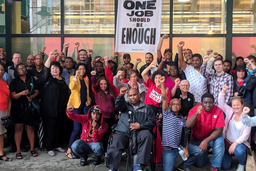20,000 Delta Flight Attendants Prepare for ‘Biggest [Union] Drive In the History of the Industry’
Bruce Vail

Delta Air Lines is once again the focus of a nation-wide union organizing campaign, with a rank-and-file election by about 20,000 of the company’s flight attendants now expected to take place in the spring or early summer.
The International Association of Machinists & Aerospace Workers (IAM) moved to start the formal election process January 13, when it filed documents with the federal National Mediation Board (NMB) demonstrating that nearly 12,000 Delta flight attendants are in favor of holding an election. The NMB, which oversees labor relations in the railroad and commercial airline sectors, is expected to act in February or March to set the precise dates, and determine other election details, says IAM spokesperson James Carlson.
“This is historic. It’s the biggest airline drive in the history of the industry,” Carlson says, noting that the total number of Delta flight attendants had grown since 2010 when a similar union organizing drive by the Association of Flight Attendants-Communications Workers of America (AFA-CWA) was defeated in an aggressive anti-union effort by Delta managers. Two earlier efforts by AFA-CWA — in 2001 and 2008 — were also voted down by Delta attendants.
Several differences between the 2010 and 2015 union campaigns bode well for success this time, says Julianna Helminski, a veteran flight attendant who is actively supporting the IAM drive and was also a supporter of the 2010 drive. The 12,000 signed election authorization cards gathered by union organizers represents about 60 percent of the eligible voters, she says, so this by itself indicates majority support for the union. Although a drop-off in union support from the beginning of the election process until the end is common, Helminski concedes, the 12,000 signed cards were gathered over a two year period of active organizing that has solidified union support. That’s in contrast to 2010 when pre-election support for the AFA-CWA was much softer, she explains.
The earlier drive also took place in an atmosphere of apprehension over the acquisition of Northwest Airlines by Delta, Helminiski says, and the merger of the flight attendants lists of unionized Northwest and non-union Delta. Many workers feared job cuts as a result of the merger, a fear that proved unfounded as Delta has shown strong profitability in the intervening years.
“Plus, there was the process of the attendants getting to know one another person-to-person. The Northwest and Delta attendants were strangers in 2010, but since then we have worked together side-by-side. Now we know we have the same concerns and the same issues” with how the airline is managed, she says.
One of the most obvious differences is that the pro-union forces are seeking to join the IAM rather than the AFA-CWA. Helminski says the attendants initial organizing group went to the IAM in 2012 to ask the union to support the drive after intense internal discussion about the different alternatives. A consensus developed for the IAM — despite the fact that AFA had represented the Northwest attendants before the merger — based on aggressive and persistent attempts by IAM to organize some of Delta’s non-attendant workers.
“We had a solidarity committee with the ramp workers after the merger, and we got to know the IAM people pretty well. I think it’s fair to say that most of us were impressed,” Helminski says.
Inter-union rivalry has been largely put aside for this new attempt to organize the Delta attendants, IAM’s Carlson adds, and the AFA-CWA has officially endorsed the IAM campaign. Likewise, a second union representing flight attendants — the Association of Professional Flight Attendants — has also endorsed the IAM effort, Carlson says.
Airline organizing in general seems to be trending in favor of unions. One of biggest organizing successes of 2014 was the unionization of about 14,500 passenger service agents at American Airlines, who joined the CWA. Also unionizing last year were the flight attendants at Virgin America and the pilots at JetBlue, who joined the Transportation Workers Union and the Air Line Pilots Association, respectively.
Key to the campaign is likely to be about 3,000 Delta attendants who have been hired since AFA’s 2010 election defeat and thus have not yet had a chance to show their preference one way or the other Helminski says. (The 2010 loss was decided by a plurality of only about 300 anti-union votes.) Organizers have set up a special unit aimed specifically at these 3,000, and early indications are positive.
With Delta recording consistent profits in the last five years, new hires especially are wondering why attendant wages lag 26 percent behind industry leader Southwest Airlines, she says. Total compensation, including all benefits, is slightly below the industry average, Helminski says, so many Delta attendants are looking for improvement in this area as well.
Asked whether Delta would actively oppose the IAM campaign, the company provided the following comment from Allison Ausband, Senior Vice President of In-Flight Services:
The IAM’s poor track record at other airlines, together with its culture of divisiveness, harassment and personal attacks, would not benefit Delta flight attendants. Working directly with Delta leaders, Delta flight attendants have enjoyed greater pay increases than flight attendants at other airlines since 2007 and they have a superior package of top-tier pay rates and an industry-leading profit-sharing program, along with competitive benefits and flexible work rules. Quite simply, our flight attendants deserve better than the IAM.
IAM’s Carlson said the vigorous anti-union campaign by Delta managers is expected, but that the union is nevertheless “confident” of success.
The IAM and CWA are sponsors of In These Times. Sponsors play no role in editorial content.







